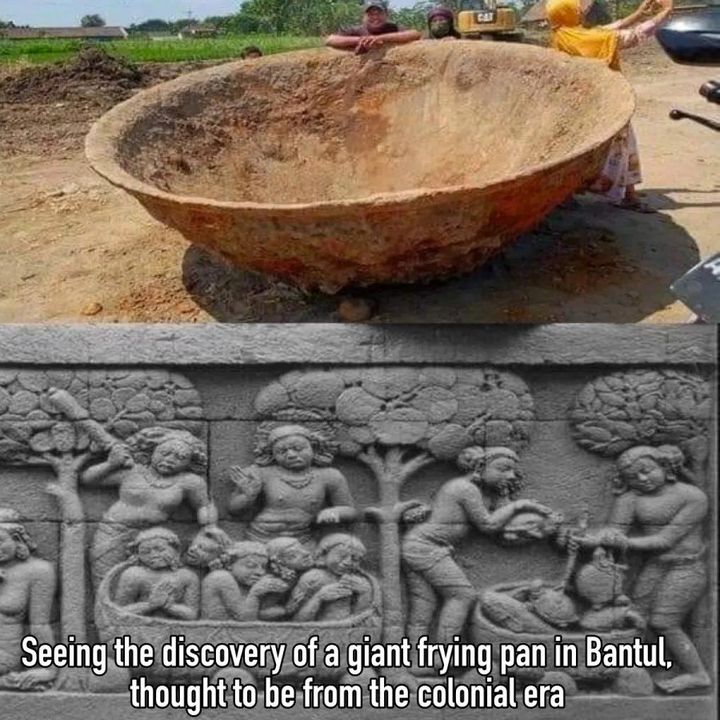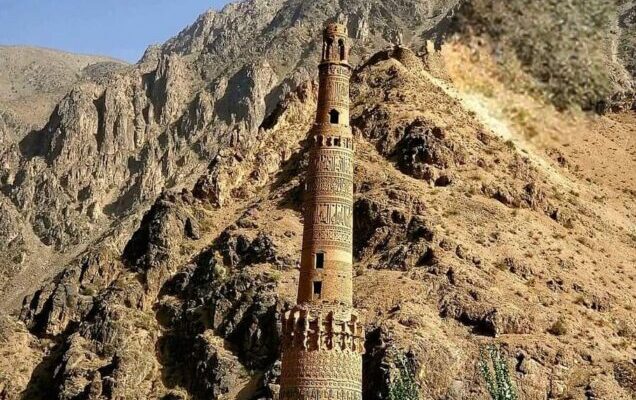In the intriguing world of ancient giants, a photograph has emerged that raises many questions. The image depicts an artifact with an uncanny resemblance to a giant frying pan, and it was discovered quite by accident on August 31, 2021, during road construction in Bantul, Indonesia. This unexpected find has ignited a surge of curiosity and speculation.

Adding to the enigma, another piece of the puzzle comes from a bas-relief on the walls of the Karma-Vibhanga, housed within the iconic Borobudur Temple in Central Java. This sprawling temple complex is renowned for its intricate carvings and depictions of historical events. The image in question is part of a larger panel composed of three distinct fields. In the middle panel, we witness scenes of people engaging in mysterious activities, seemingly preparing within a colossal flaming cauldron, with towering giants by their side.A remarkable aspect of this discovery is the intriguing geographical separation between the artifact’s location and the Borobudur Temple. The distance spans approximately 50 kilometers, raising further questions about potential connections or influences. While this mystery continues to unfold, it’s essential to note that this content has been created by me, and the photograph used is not my own, with full credit being rightfully attributed to its respected owners.

Merdeka.com – Residents of Kretek Hamlet, Jambidan Village, Kapanewon Banguntapan, Bantul were recently shocked by the discovery of a giant frying pan. Its size is not half-hearted, its height reaches 1 meter and its diameter is estimated to reach 2-2.5 meters. This unique discovery has also succeeded in attracting the attention of local residents.
This giant frying pan was discovered on Tuesday (31/8/2021) afternoon by an excavator operator. The plan is to build a football field on this village treasury land. When dredging at a depth of around 3 meters, the tip of the excavator touched a hard object such as iron.

Intrigued, officers immediately dug up the soil around the area. After observing it as a whole, the hard object turned out to be a jumbo-sized frying pan. After the discovery, local residents immediately reported the incident to the Cultural Heritage Conservation Center (BPCB).
The large size of the pan requires that the process of dredging the soil around the area is quite time consuming. It took around 3 hours for the officers to remove the buried frying pan and move it near the discovery location. The evacuation process only ended at 5 pm.
Reporting from CNN, the Cultural Heritage Authority has carried out an examination regarding this discovery. The Cultural Heritage Department ensures that this frying pan is not an ancient item but a relic from the Dutch era. However, this giant frying pan is a historical object.

A yellow police line circles around the area where the frying pan is located. A marker so that not just anyone can pass it. Since it was discovered, this giant frying pan has become an impromptu tourist attraction for local residents. Many people come because they are curious about the shape of this jumbo frying pan.
From morning to evening, many people come to see this wok. Some people stop by after cycling in the morning, coming home from work or walking with their children. Don’t forget to take a photo in front of this copper frying pan.

Until now (3/9/2021), the frying pan is still at the location and has not been evacuated by the BPCB. However, residents hope that this giant frying pan will remain at the location and will not be taken from the BPCB.
The reason is, the pan area could be built with a monument for a new tourist destination in Dukuh Kretek, Jambidan. In order to increase residents’ income in the midst of PPKM.

Apparently, this is not the first time a giant frying pan has been discovered. Several regions in Indonesia have also been shocked by the presence of buried jumbo frying pans.
In 2106, a giant frying pan was discovered in Kutoarjo. Likewise, in Batang, Central Java, a giant frying pan with a diameter of 2 meters was found during the construction of a mosque.

